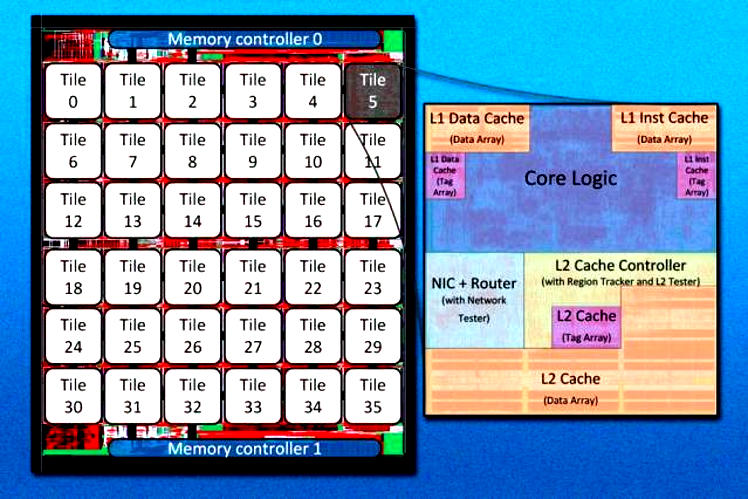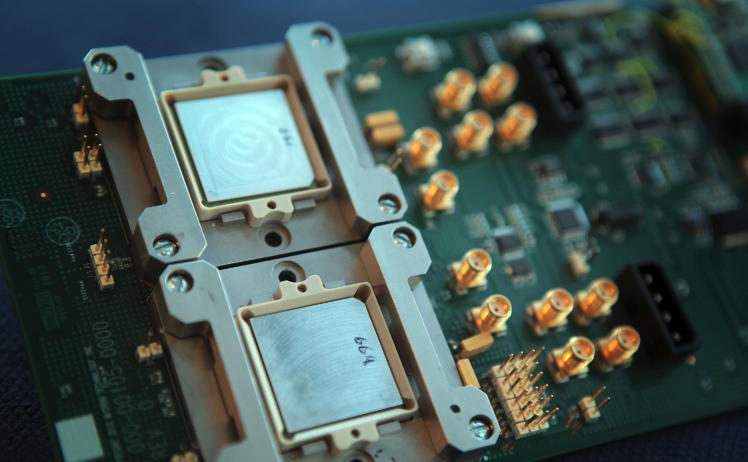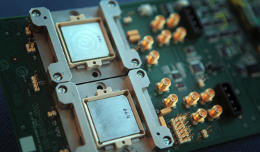Last week the worlds’ eyes were focused on Google I/O. We in Colombo were focused on a ton of other tech events along with it, such as the Colombo Agile Conference, TEDx and Social Media Day.
Meanwhile, across the globe, at smaller tech events (that got eclipsed), some amazing breakthroughs in technology made their debuts.
MIT built a 36 core processor with its own network
A 36 core processor packs a ton of power. However the problem with processors today is that, as the number of cores increase, each core has to wait longer for the data bus connecting the cores to be free (so they can transmit). This wastes computing time. This is called cache coherence, and what we’ve given is just a simple outline. But onto the processor:

The researchers at MIT have solved this issue using the network-on-chip concept where each core has its own router and is connected only to those immediately adjacent to it, with a second shadow network used to maintain cache coherence. That’s pretty hardcore.
In short, the two networks are used to enable higher volumes of data to be processed and cached at the same time. With this new approach, the MIT team has identified a 24.1% performance increase over traditional multicore processors. You can read more about it on the MIT website here.
Intel talked about its new super powered processors
It has more than 60 cores and it can deliver over 3 teraflops of peak performance. It’s also rumoured to support up to 384GB of DDR4 RAM and up to 16GB of Hybrid Memory. This is what Intel’s new supercomputing processors – dubbed Knights Landing – bring to the table.
The first computer to get Knights Landing would be the Cori supercomputer in 2016. You can find out more about Knights Landing in the official press release here – and yes we just said DDR4. Which brings us rather neatly to the next one…
DDR4 is coming!
Finally after 7 long years since DDR3, DDR4 memory has appeared and will be arriving for high-end desktops and servers in the third quarter this year. How much will it cost? No exact figures have been released but it’s estimated to cost 20-40% more than DDR3 memory.
DDR4 brings an expected performance boost and a much needed improvement in energy consumption. This means that smartphones and other portable devices can benefit from longer battery lives once DDR4 hits the mass market.
In fact, the Snapdragon 810 mobile processor uses low-power DDR4 memory, and devices using this chip are expected to ship in the first half of 2015. As for high-end desktop users, Intel’s upcoming X99 chipset will support DDR4 memory, along with a new Extreme Edition of its Haswell CPU (codenamed Haswell-E).
Mind you, DDR4’s been “coming” for ages (Samsung already did this, and Crucial / Micron demo’d this in 2013), but we’ve got hope now that processors that support it will be launched. But as awesome as DDR4 sounds, it already has a competitor.
The alternative to RAM – Hybrid Memory Cubes
As its subsidiary Crucial announced DDR4, Micron shockingly announced an alternative competitor to DDR4 and another replacement for DDR3: the Hybrid Memory Cube (HMC for short). We’re not sure how the politics at Micron work but we do know how the technology works.

Unlike traditional DRAM, HMC mates a DRAM stack and with a logic process layer for buffering and routing. Memory modules are placed as stacked chips in cubes (now we know where the name comes from) as opposed to being placed flat next to each other on a motherboard. Providing 5 times more bandwidth than DDR4 while drawing 70% less energy than DDR3, it’s safe to say the HMC is giving DDR4 a solid beating terms of performance.
Currently the HMC is in its testing phases with 4GB and 8GB versions sent to chip and server manufacturers for trial runs. However, we won’t be getting out hands on HMC yet. Intel is planning on making its new Xeon Phi supercomputing chips (Knights Landing) compatible with HMC, but it’ll be long time before we consumers get to play around with it. You can read more about HMC here.
Japan introduces first Android newscasters
No we’re not talking about the operating system. This is Japan, the land where awesome robots are born. Quite recently it’s given birth to two more. Say hello to the Kodomodroid and the Otonaroid, Japans newest Androids with a very lifelike appearance.
Created by a team led by Hiroshi Ishiguro, an Osaka University and Advanced Telecommunications Research Institute International (ATR) roboticist, the androids will be employees of the National Museum of Emerging Science and Innovation (Miraikan) in Tokyo, along with another less life like Android known as the Telnoid.
As incredibly lifelike as these robots look, they are still far from being perfectly human in terms of behaviour. So it’ll at least be a decade or two before we can imagine events where androids go haywire and start attacking humans, like in sci-fi movies such as Ghost in the Shell. Phew.
Intel introduces its 21st century robot project
Now if you were imagining a robot while reading about the previous, Intel has a piece of hardware for you to help make that imaginary robot a reality-if you have $1500 and a 3D printer.
The idea behind this project is to bring about a robot revolution with the help of DIY robot enthusiasts. (No not one where they take over the world – more like the one where PC’s and smartphones became mainstream).
The first robot to be born out of this project is Jimmy. Jimmy is 17 inches tall and just like how we customize our smartphones downloading apps, Jimmy can be customized to do a variety of tasks.
To make Jimmy carry out a task, just write the program for it in HTML 5 and load it into Jimmy. Once that’s done you can control Jimmy with your smartphone, tablet or your PC. Intel has also announced that in the future Jimmy will receive its own app store. They definitely weren’t kidding when they said Jimmy is like a smartphone.
While the actual plans for Jimmy and development tools are open source, the heavy price tag comes from the actual parts Jimmy is built with – such as its processor, 3D depth-sensing cameras and powerful legs.
Despite the heavy price tag, we are looking forward to see what robot enthusiasts can create with Jimmy. After all, to when PC’s and smartphones first arrived, they were as expensive as your kidneys.
Mood capturing cameras coming to tablets near you
While one team at Intel is busy with making robots mainstream, another is busy trying to improve how we interact with our computers. Say hello to the RealSense 3D camera, which is the product of Intel’s “perceptual computing” initiative. The goal of this initiative is to allow us to communicate with our computers more naturally.
The ReadSense 3D camera is a 1080p web cam that features gesture recognition and can identify your emotions after analysing your face. Furthermore, it can also change the background of your video calls on Skype. Additionally, you can also use it to scan 3D objects and then either print it using a 3D printer or even insert it into something like 3DS Max.
In the near future, Intel plans to use this to make children’s books more interactive and with this in mind has made a deal with Scholastic to develop such features. While the technology still has a few bugs to be fixed, you can expect RealSense 3D cameras in Windows and Android tablets that come out in the first quarter next year.







GIPHY App Key not set. Please check settings